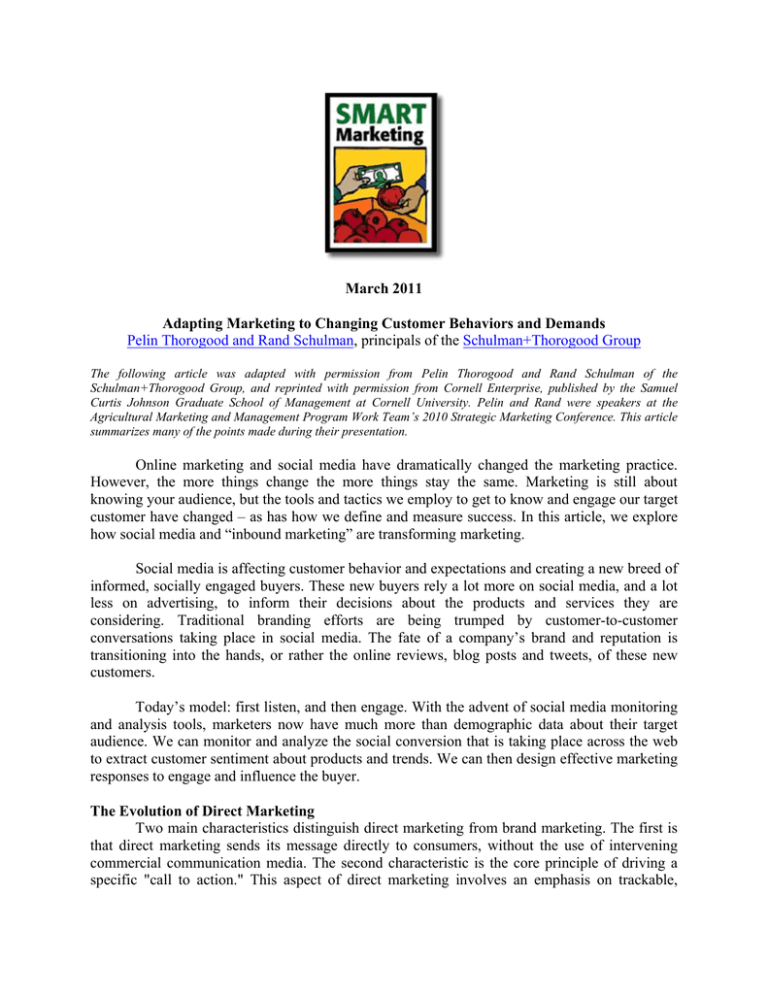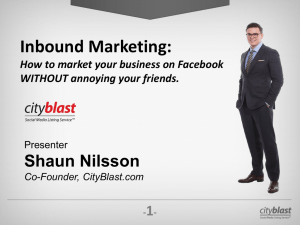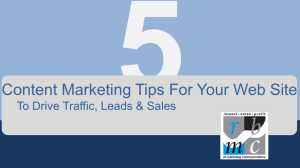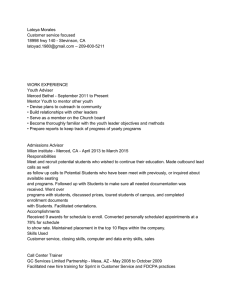, principals of the March 2011
advertisement

March 2011 Adapting Marketing to Changing Customer Behaviors and Demands Pelin Thorogood and Rand Schulman, principals of the Schulman+Thorogood Group The following article was adapted with permission from Pelin Thorogood and Rand Schulman of the Schulman+Thorogood Group, and reprinted with permission from Cornell Enterprise, published by the Samuel Curtis Johnson Graduate School of Management at Cornell University. Pelin and Rand were speakers at the Agricultural Marketing and Management Program Work Team’s 2010 Strategic Marketing Conference. This article summarizes many of the points made during their presentation. Online marketing and social media have dramatically changed the marketing practice. However, the more things change the more things stay the same. Marketing is still about knowing your audience, but the tools and tactics we employ to get to know and engage our target customer have changed – as has how we define and measure success. In this article, we explore how social media and “inbound marketing” are transforming marketing. Social media is affecting customer behavior and expectations and creating a new breed of informed, socially engaged buyers. These new buyers rely a lot more on social media, and a lot less on advertising, to inform their decisions about the products and services they are considering. Traditional branding efforts are being trumped by customer-to-customer conversations taking place in social media. The fate of a company’s brand and reputation is transitioning into the hands, or rather the online reviews, blog posts and tweets, of these new customers. Today’s model: first listen, and then engage. With the advent of social media monitoring and analysis tools, marketers now have much more than demographic data about their target audience. We can monitor and analyze the social conversion that is taking place across the web to extract customer sentiment about products and trends. We can then design effective marketing responses to engage and influence the buyer. The Evolution of Direct Marketing Two main characteristics distinguish direct marketing from brand marketing. The first is that direct marketing sends its message directly to consumers, without the use of intervening commercial communication media. The second characteristic is the core principle of driving a specific "call to action." This aspect of direct marketing involves an emphasis on trackable, measurable, positive responses from consumers, regardless of medium. Online marketing technologies and methodologies have transformed this originally print-based marketing form, making it one of the most predictable and accountable sources of demand generation. Here’s how: • Email marketing is replacing print-based direct marketing efforts as a more personalized, cost-effective, as well as green alternative. • Behavioral targeting (i.e., serving different Web pages to different visitors based on their prior Web site actions) enables businesses to present a personalized – and thus more relevant – web site experience to their visitors. • Web analytics empower marketers with the intelligence to determine if web site visitors from different programs or campaigns (e.g., banner advertising, Google adwords, LinkedIn, etc.) have more or less propensity to engage on the site (e.g., buy, fill out a form, read an article). Enter Inbound Marketing Traditional (or outbound) marketing focuses on finding customers by building brand awareness and demand through activities such as PR, online and offline advertising, direct mail, and email promotions. It is the company reaching out to the customer to entice them to buy their products and services. Because of interrupt-driven and program-heavy (i.e., costly) outbound marketing campaigns, we are inundated with solicitations. Banners and pop-ups invade Web sites while spammers invade mail and email boxes. The problem: today’s new customer does not want to be sold to. They want to find the right products and services themselves. Inbound marketing is a new approach to marketing that optimizes being found by customers, and attracts qualified buyers to the business. Social media engagement, search engine optimization, and link-building are all examples of effective inbound-marketing activities. Inbound marketing not only benefits the business by improving web site “findability” by qualified buyers, but also benefits the visitor with improved content relevancy and linked resources. Inbound marketing activities tend to be more people-heavy, rather than programheavy since they rely on relevant content creation and community engagement. Creating a content-rich web site ― building relevant links, blogging, commenting on other’s blogs, tweeting, and currating discussion boards on Facebook and LinkedIn ― all take time, but not a lot of program dollars. Inbound marketing leverages social media and networking to target and attract qualified buyers, and encourages the adoption of a culture of measurement to optimize the effectiveness of the inbound marketing mix. Creating a Virtuous Marketing Cycle™ The key to engaging customers is relevance, and relevance comes from a deeper understanding of customer behavior and sentiment. It comes from listening to the customer through all the newly available mediums before crafting the marketing messages for those mediums. The demands of the new breed of customer are not only forcing the evolution of the marketing practice but the marketing practitioners as well - and a new breed of marketer is emerging – the Content Engineer™. They listen to and engage customers in social media, building trust in their brand. They analyze visitor behavior and sentiment to optimize web site content for visitors as well as search engines. They invest in quality link building to establish their web site in a community of related sites. Rich with buyer insights gleaned from inboundmarketing efforts, they charge forward with more effective outbound-marketing campaigns that resonate with customers in the here and now. Empowered with new tools to decipher the new customer and the insights to engage them effectively in all the new marketing mediums, the new marketer has what it takes to synchronize the marketing cycle with the buying cycle – creating a virtuous cycle for businesses and customers alike. Inbound marketing strategies will be unique to a firm based on their overall business goals and objectives, current activities and preferences, and a host of other factors. What’s right for you, may not be for your neighbor. Nevertheless, in today’s social media driven world, it’s worth the effort to sit back and think about how you can best leverage your outbound marketing strategies with today’s inbound marketing opportunities. The full video podcast of Pelin and Rand’s presentation at the Strategic Marketing Conference is available on the PWT website. To read more, please check out the Fall 2010 edition of Cornell Enterprise, “The Birth of Customer 2.0 and the Death of Marketing As We Know It,” 6 Dec 2010, at: http://www2.johnson.cornell.edu/alumni/enterprise/fall2010/index.cfm?action=web_extra&web_extra_id=5. “Smart Marketing” is a marketing newsletter provided by the Cornell University Agricultural Marketing & Management Program Work Team for extension publication in local newsletters and for placement in local media. It reviews elements critical to successful marketing in the food and agricultural industry. Please cite or acknowledge when using this material. Past articles are available at http://marketingpwt.aem.cornell.edu/publications.html.



